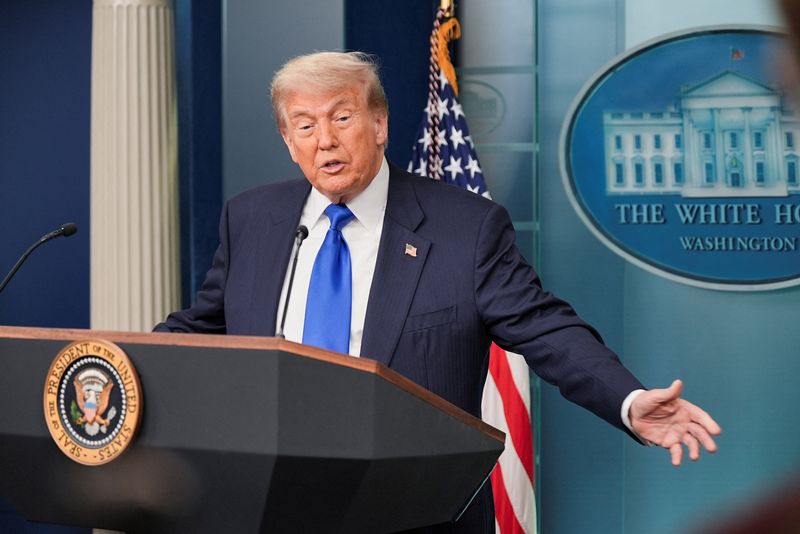Trump hammers Powell again as Bessent mulls Fed power transition timeline

By Michael S. Derby and Howard Schneider
(Reuters) -President Donald Trump on Monday continued hammering at the U.S. Federal Reserve to ease monetary policy, sending Fed Chair Jerome Powell a list of central bank interest rates around the world adorned with handwritten commentary saying the U.S. rate should be between Japan’s 0.5% and Denmark’s 1.75%, and telling him he was “as usual, ‘too late.'”
“You should lower the rate by a lot. Hundreds of billions being lost,” Trump said in the note, which was also posted to social media with further commentary from the president saying that being a central banker in the U.S. was “one of the easiest, yet most prestigious jobs in America, and they have FAILED…We should be paying 1% interest, or better!”
A 1% policy rate in the past in the U.S. has been associated with weak, even recessionary economic growth rates and periods of low inflation.
As have many of Trump’s posts on monetary policy this one seemed to conflate the benchmark short-term interest rate set by the Fed with the interest rate investors demand to hold U.S. and other debt, which can be influenced by Fed policy but is also connected to views about the U.S. economy, inflation, geopolitics and institutional stability.
With the unemployment rate low and inflation above their 2% target, Fed officials have been reluctant to cut interest rates from the current 4.25% to 4.5% range until it is clear that the Trump administration’s tariff plans won’t lead to a fresh surge in prices.
Federal Reserve officials continued to raise those concerns on Monday, while Treasury Secretary Scott Bessent began mapping out the likely plan for naming Powell’s replacement for when he leaves the job next May.
Trump cannot fire Powell over a policy dispute, but last week urged him to resign.
Bessent in recent days, by contrast, has pointed to a more conventional handover of power at the Fed instead of attempts to influence monetary policy through early appointment of a “shadow chair” or other methods.
“There’s a seat opening up…in January. So we’ve given thought to the idea that perhaps that person would go on to become the chair when Jay Powell leaves in May,” Bessent said on Bloomberg TV. Current Governor Adriana Kugler’s term expires in January. Bessent on Friday said a January opening would “probably mean an October, November nomination” and Senate confirmation following.
One person under consideration as chair, Governor Christopher Waller, is already on the board and participating in monetary policy discussions; others, like former Governor Kevin Warsh, would remain on the sidelines until a seat comes open and the nominee for it is confirmed by the Senate.
SUMMER DATA THE KEY
Though Trump’s insistence on rate cuts could make for a difficult confirmation hearing – the Fed is supposed to act independently of the wants of elected officials – data this summer will be key to whether tensions between the White House and the central bank intensify or ease in coming weeks if policymakers find a path to rate cuts on their own.
Investors expect the Fed to resume cutting the benchmark policy rate at the September meeting and move steadily lower from there. Economists from Goldman Sachs, who have been pessimistic about the U.S. growth and inflation outlook and had expected the Fed to wait until the end of the year to cut rates, on Monday pulled their estimated first cut into September as well.
“We thought that the peak summer tariff effects on monthly inflation would make it awkward to cut sooner. But the very early evidence suggests that the tariff effects look a bit smaller than we expected, other disinflationary forces have been stronger, and we suspect that the Fed leadership shares our view that tariffs will only have a one-time price level effect,” Goldman economists wrote.
Waller has said cuts could be warranted as soon as the Fed’s July meeting, and paused if inflation does begin to rise.
The Fed receives new jobs data on Thursday, covering the month of June, which will indicate if the labor market is beginning to sputter, a development that could also add to the case for rate cuts sooner rather than later. New inflation data is released next week.
July 9 is also top of mind for the Fed: That’s the day the current suspension of some of Trump’s tariffs expires, and it remains unclear whether import taxes will skyrocket or Trump’s program be delayed again pending negotiations.
Federal Reserve Bank of Atlanta President Raphael Bostic repeated on Monday that he still sees the central bank cutting its interest rate target just once this year, while suggesting there’s no urgency to act given the level of uncertainty.
“I think we actually have some luxury to be patient because labor markets are actually quite solid,” Bostic said in an event hosted by Market News International. “I think there is actually more pricing to come, and it is more a question of time, of when and not if…This is still going to take some time before we’ll sort of know the answer to those sorts of things.”
(Reporting by Michael S. Derby; Additional reporting by David Lawder; Editing by Andrea Ricci)









